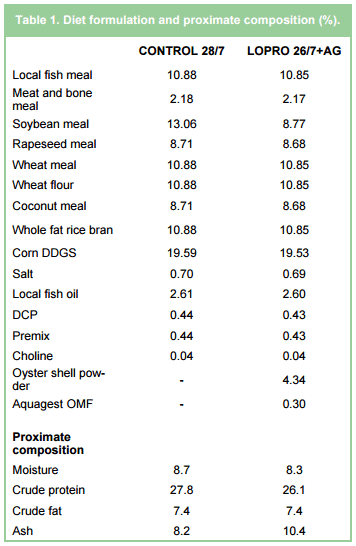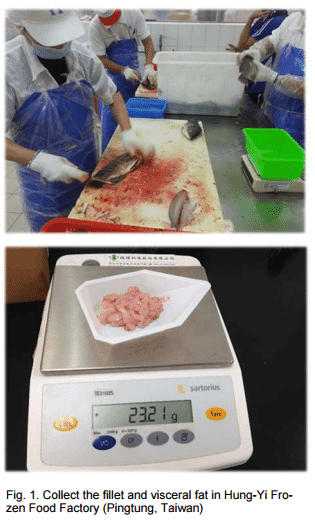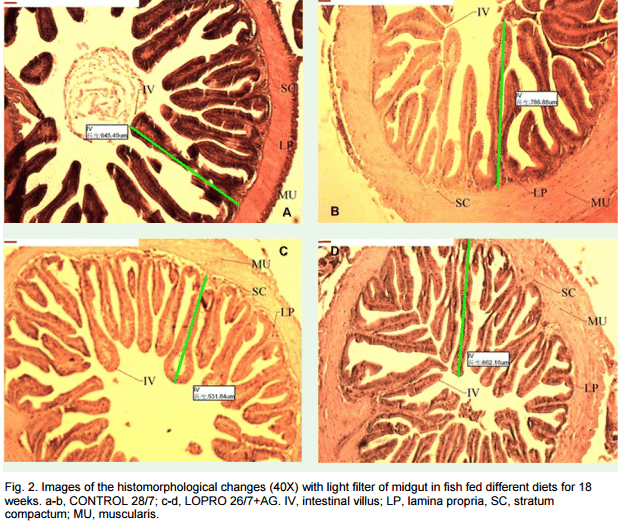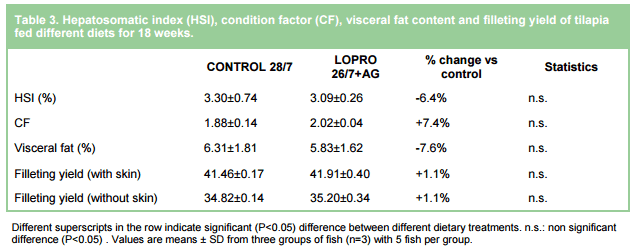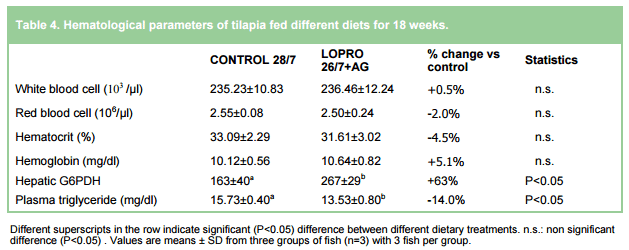Production of tilapia has been increasing throughout the world and a future increase in production has been projected. As the industry expands and technology development continues, traditional extensive culture of tilapia is being replaced by semi-intensive and intensive production systems.
As stocking rates increase, the contribution of natural food decreases and more nutritionally complete diets are needed. In semi-intensive and intensive culture systems, diet is the most expensive cost item, often ranging from 30% to 60% of the total variable expenses, depending on the intensity of the culture operation. Thus, the use of least-cost, nutritionally balanced diets and good feeding management are two most important requisites for successful fish production.
Traditionally, dietary non-protein energy sources, such as carbohydrate or lipid have been demonstrated to spare the protein for tilapia (Shiau, 2001). However, these common carbohydrate sources also show low digestibility due to the high fiber content, whereas high dietary fat levels cause fatty fish. Therefore, feed additives that can improve nutrient utilization have a potential to promote protein sparing in tilapia and reduce the feed cost per kg of fish and/or filet produced.
Previous work has revealed the potential of synergistic blends of digestive phytobiotics, natural emulsifying agents and co-factors of digestion to improve feed efficiency and growth and to reduce visceral depositions in Nile tilapia under lab (Ceulemans et al., 2009) as well as field conditions (Sampaio Gonçalves et al., 2012). The present study was conducted to investigate the use of a feed additive with digestive/metabolic enhancing action to reduce dietary protein level in Tilapia without affecting performance and final product quality. During this trial, a wide range of parameters were evaluated, including fish performance, filleting yield, metabolic indicators, lipid utilization and intestinal morphology.
Growth trial
Experimental diets (formulation and composition are shown in Table 1) were designed by National Pingtung University of Science and Technology (NPUST) based on a common feed formulation for tilapia in Taiwan. The diets were extruded by Tungkang Biotech Research Center (Pingtung, Taiwan). The feed additive with digestive/metabolic enhancing properties consisted of Aquagest® OMF (Nutriad International, Belgium). Experimental diets consisted of a control diet (28% protein and 7% lipid without Aquagest OMF, coded as CONTROL 28/7) and a test diet with 2% less protein and the feed additive added (26% protein and 7% lipid, 0.3% Aquagest OMF; coded as LOPRO 26/7+AG).
Male hybrid tilapia (Oreochromis niloticus × O. aureus) were supplied from the local farm in Tainan, Taiwan. All the fish were reared at the “88 platform” test farm in Changjhih, Pingtung.
Upon arrival, they were acclimated to farm conditions for 2 month in a cement pond [5 m (w) × 5 m (l) × 0.75 m (h)] and fed commercial tilapia diet (Hanaqua Tech Inc., Taiwan). The conditions during the acclimation period were similar to those at the initiation of the experiment. Three cement ponds were used for the feeding trial. Each pond was divided into two parts by a nylon net. Forty five tilapia with average initial weight of approximately 175 g were randomly selected into each pond. Fish were reared in a flow-through system with underground freshwater. Around 80% of the water in the system was changed every three weeks.
Fish were fed with 2-2.5% of their body weight per day. This amount was close to the maximal daily ration for tilapia. The daily ration was divided into two equal meals (08:00 and 15:00 h) and hand-fed to the fish. Fish were weighed once every 3 weeks by students from NPUST, to monitor growth performance and adjust feeding rations. Fish were fed the test diets during 18-weeks from July 28 to November 30, 2013. Water temperature was recorded every day. Other water quality parameters, including ammonium and nitrite concentrates were determined every week by NPUST.
At the end of the feeding trial, body length and weight of tilapia were recorded. Weight gain (WG, as measured by the percentage of body weight gain), feed efficiency (FE), protein efficiency ratio (PER), protein retention, condition factor and hepatosomatic index were calculated. Five fish were sampled randomly to be sacrified. Liver, blood and muscle were collected and stored in - 20°C until analysis.
The midgut samples were analyzed by histological assay. Blood was examined on the hematological parameters, including red blood cell count, hematocrit and hemoglobin concentration, and plasma triglyceride concentrations. Proximate composition of muscle was also measured. Thirty fish were transferred to Hung-Yi Frozen Food Factory (Pingtung, Taiwan, Fig. 1) to determine the fillet yield (%) and visceral fat (%).
Multiple effects from supplementing the feed additive to a low protein feed
Growth performances of tilapia fed different diets were shown in Table 2. Fish fed LOPRO 26/7+AG, grew faster (daily weight gain 5.2% higher) than control fish, although these differences were not significantly different. FCR, pro tein efficiency ratio (PER) and protein retention were significantly better (P<0.05) in tilapia fed the LOPRO 26/7+AG-diet compared with the control (showing -7.1%, +14.8% and +7.3%, respectively, change versus control). These results clearly indicated that the supplementation of the feed additive showed positive effects on protein utilization and growth for tilapia, resulting in an effective protein sparing effect.
Visceral fat (Table 3) and plasma triglyceride concentrations (Table 4) in fish fed LOPRO 26/7+AG, showed -7.1% and -14.0% reduction compared to the control group. This indicates that the feed additive ingested by tilapia can enhance lipid utilization and decrease the metabolism of protein to energy by the fish.
In addition, hepatic glucose-6-phosphate dehydrogenase (G6PDH) activity was higher in the LOPRO 26/7+AG group compared to control fish (Table 4). This enzyme is involved in the pentose phosphate pathway to generate the coenzyme NADPH for metabolism. High performance of G6PDH generally indicates high activity of fatty acid synthesis derived from carbohydrate. In the present study, enhanced G6PDH activity indicated a higher rate of carbohydrate utilization in fish fed the feed additive.
The improvement of nutrient utilization was also reflected in filleting yield. Tilapia fed LOPRO 26/7+AG showed 1.1% higher filleting yield (Table 3) compared to control fish.
Hematological parameters, including WBC, RBC, Hct and Hb, were not affected by the dietary treatments (Table 4). These results suggest that in the present trial, the general health status of Tilapia was not influenced by the changes in dietary protein levels or the supplementation of the feed additive. The histological evaluation of midgut from all treatments (Fig. 2) showed a little atrophy in fish fed diets without Aquagest OMF compared with fish fed diets with Aquagest OMF. In all experimental diets, many plant ingredients were used, such as soybean meal, rapeseed meal, wheat meal, wheat flour, coconut meal, rice bran and corn DDGS. By our knowledge, anti-nutritional factors in plant ingredients were considered to cause intestinal enteritis for fish. So the damage to the villi was commonly found in fish fed plant-based diet. In the present study, the villi integrity in fish fed diets supplemented Aquagest OMF was better than that in fish fed diets without the feed additive.
Conclusion
The present study demonstrated that the dietary protein level can be reduced in tilapia by supplementing a feed additive capable of enhancing nutrient utilization. Tilapia fed 2% less protein and supplemented with a digestive/metabolic enhancer, showed even better performance in terms of growth, FCR, PER, protein retention and fileting yield compared to control fish. Furthermore, fish fed the enhanced low protein diet showed lower levels of visceral fat and plasma triglycerides, but enhanced G6PDH activity, which indicated effects on lipid and carbohydrate metabolism. The metabolic effects can explain the release of non-protein energy, which in turn results in protein sparing and more effective utilization of protein for muscle growth. Increased nutrient utilization efficiency is key to achieve more cost-efficient feeds.
March 2015

